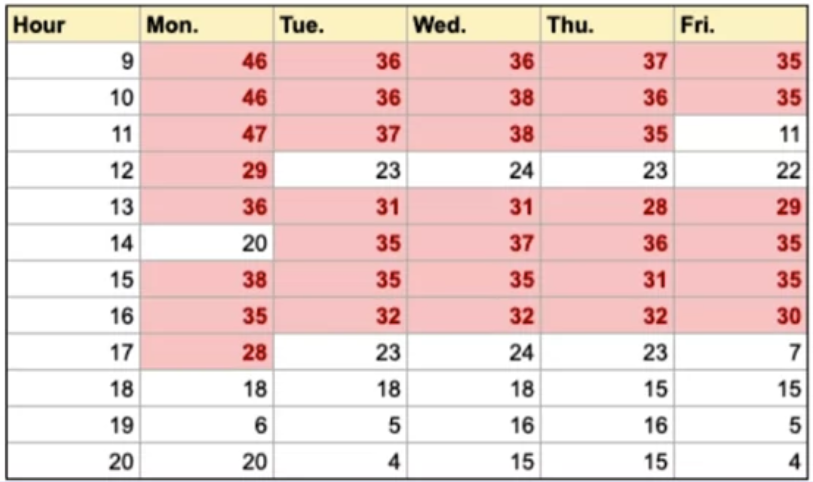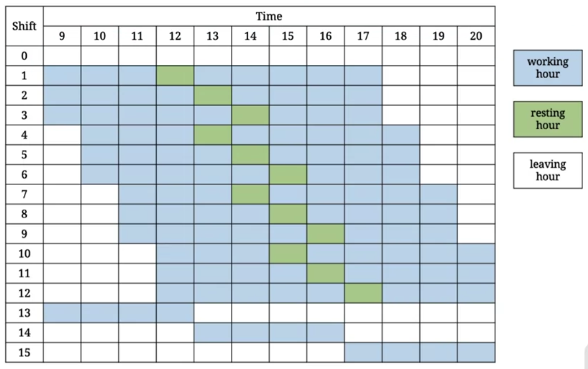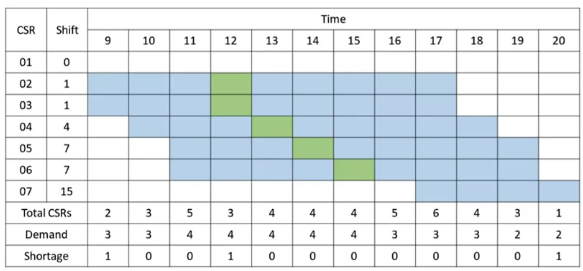Case Study: Call Center Personnel Scheduling
1. Background and Motivation
目标: 分配 CSR (customer service representatives 即客服人员) 来满足用户 call-in 的需求。通过设定 desired service level 来定义目标需求,例如 level=95% 表示至少有该比例的 call-in 被接听
根据历史数据,已知每个工作日每个时段 call-in 的大致数量

然而由于以下原因 scheduling is difficult:
- 每个接线员在一天内工作时间必须是连续的
- 每个接线员一周内最多只能上一天夜班
- 每个时间段必须有至少一名 manager
- …
由于诸如此类的原因,手动分配往往会造成很大人员的冗余。因此我们需要 schedule with operations research
2. Schedule with Operations Research
It’s an allocation problem $\to$ Linear Programming
- #CSRs is limited (接线员总人数有限)
- try to minimize total shortage (尽可能提升 service level)
It’s a selection problem $\to$ Integer Programming
- 如果一个接线员上了白班,那就不能继续上当天的夜班
- 每个接线员一周内最多只能上一天夜班
3. Problem Description (use IP)
3.1 Decisions
D1: 对于每个接线员,告诉她们下个月在哪几天工作、哪几天休息 D2: 对于每个接线员的每个工作日,告诉她们工作开始、中途休息以及工作结束的时间
In practice, use shifts to define work hours. For example:
- Shift 1: 8:00-17:00 with lunch break 12:00-13:00
- Shift 2: 8:30-17:30 with lunch break 12:30-13:30
- …
- Shift 0: a day off
例如下图展示了 Shift 0-15:

这样一来就把开头的两个 decisions 转化成了一个 shifts 分配问题: assign one shift to each CSR for each day
3.2 Objective
Minimize total shortage (尽可能提升 service level), define \(\text{shortage}=\max\{\text{Total CSRs on duty}-\text{Demand},0\}\)
例如对于下图 shifts 的分配方式,total shortage 等于最后一行的求和

3.3 Constraints
Hard constraints (must satisfy):
- Each CSR should be assigned to exactly one shift per day
- Each CSR should be assigned to at most one night shift(a shift contains work after 18:00) per week
- …
Soft constraints (nice to have):
- Fairness among periods: rather than having 5 extra CSRs in period 1 and only 1 extra CSR in period 2, it is better to have 3 extra CSRs in each period
- Fairness among CSRs: each CSR should have similar night-shifts per month
4. Model Formulation
4.1 Varaibles
Notations $i\in I$ denotes $i$th CSR $j\in J$ denotes $j$th day in the next month $k\in K$ denotes $k$th work shift $t\in T$ dnotess 工作日的 $t$th 个时刻,例如对于 9:00-20:00 这样的工作时长,$t=2$ 表示 10:00-11:00
Decision Variables \(x_{ijk}=\begin{cases} 1 & \text{if CSR }i\text{ is assigned to shift }k\text{ in day }j \\ 0 & \text{otherwise} \end{cases}\)
Derived variables: \(y_{jt}=\text{\#CSR shortage in period }t\text{ of day }j\)
4.2 Objective function
The objective function should include the major objective(minimize total shortage) and two soft constraints(fairness among periods and CSRs)
- $w_1$: max number of extra on-duty CSRs among all periods 最大服务冗余
- $w_2$: max number of night-shifts among all CSRs 最多夜班数量
where $P_0,P_1,P_2$ are weights determined by manager
4.3 Constraints
(1) For each day, each CSR should be arranged one shift \(\sum_{k\in K}x_{ijk}=1\;\;\;\;\forall j\in J,i\in I\)
(2) #CSR shortage in period $t$ of day $j$ \(y_{jt}\geq D_{jt}-\sum_{k\in K}A_{kt}\sum_{i\in I}x_{ijk}\;\;,\;\;y_{jt}\geq 0\;\;\;\;\forall j\in J,t\in T\)
where
- $A_{kt}=1$ 表示 shift $k$ 包含了时刻 $t$,反之为零
- $D_{jt}$: #CSRs needed in period $t$ of day $j$
(3) $w_1$ max mumber of extra on-duty CSRs among all periods, all days $w_2$ max number of night-shifts among all CSRs \(w_1\geq \sum_{k\in K}A_{kt}\sum_{i\in I}x_{ijk}-D_{jt}\;\;\;\; \forall j\in J,t\in T\)
\[w_2\geq \sum_{j\in J}\sum_{k\in K^N}x_{ijk}\;\;\;\;\forall i\in I\] \[w_1,w_2\geq 0\]where $K^N\subset K$ is the set of night shifts
**(4) **













Document Information
- Author: Zeka Lee
- Link: https://zhekaili.github.io/0005/01/05/case-study-for-IP/
- Copyright: 自由转载-非商用-非衍生-保持署名(创意共享3.0许可证)